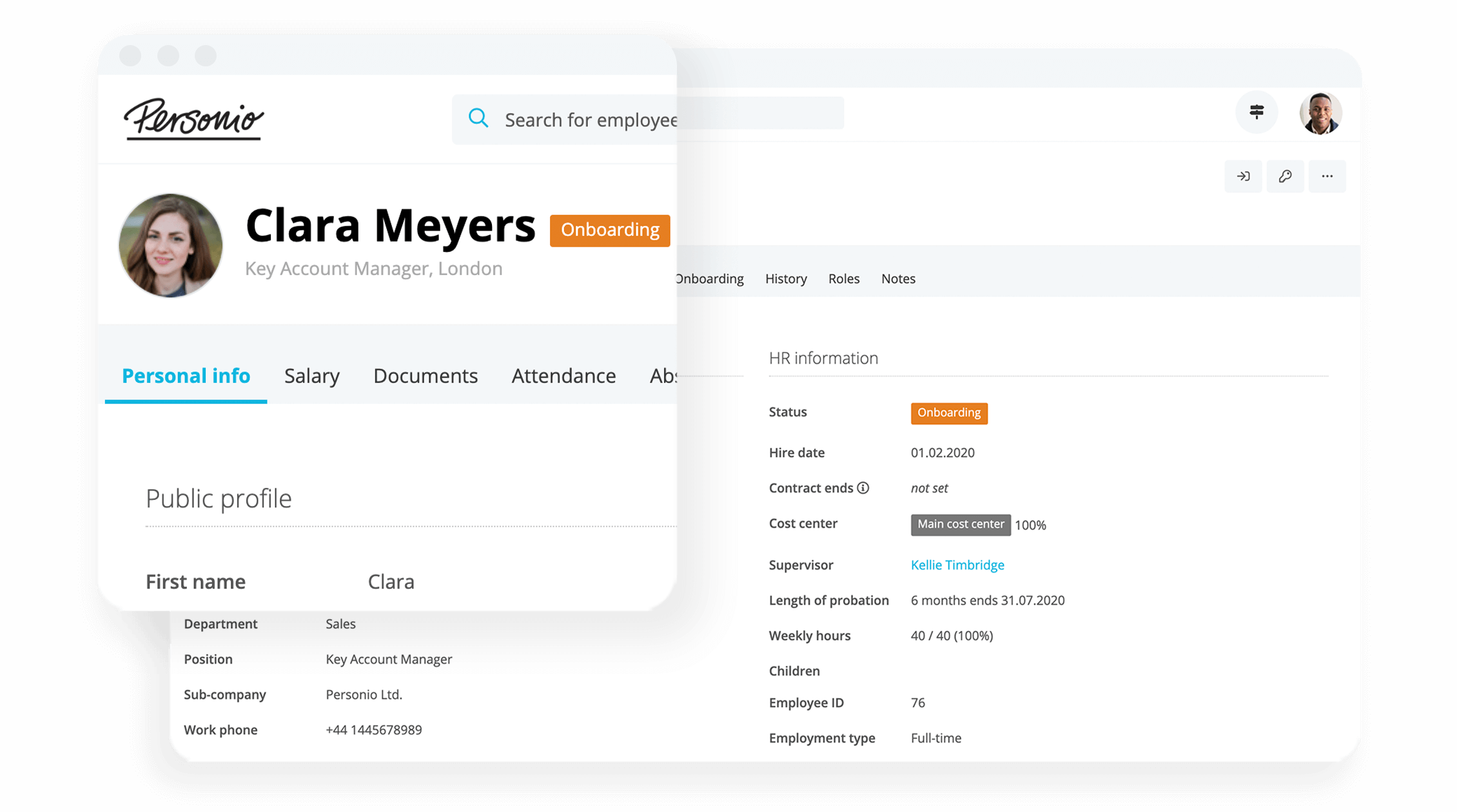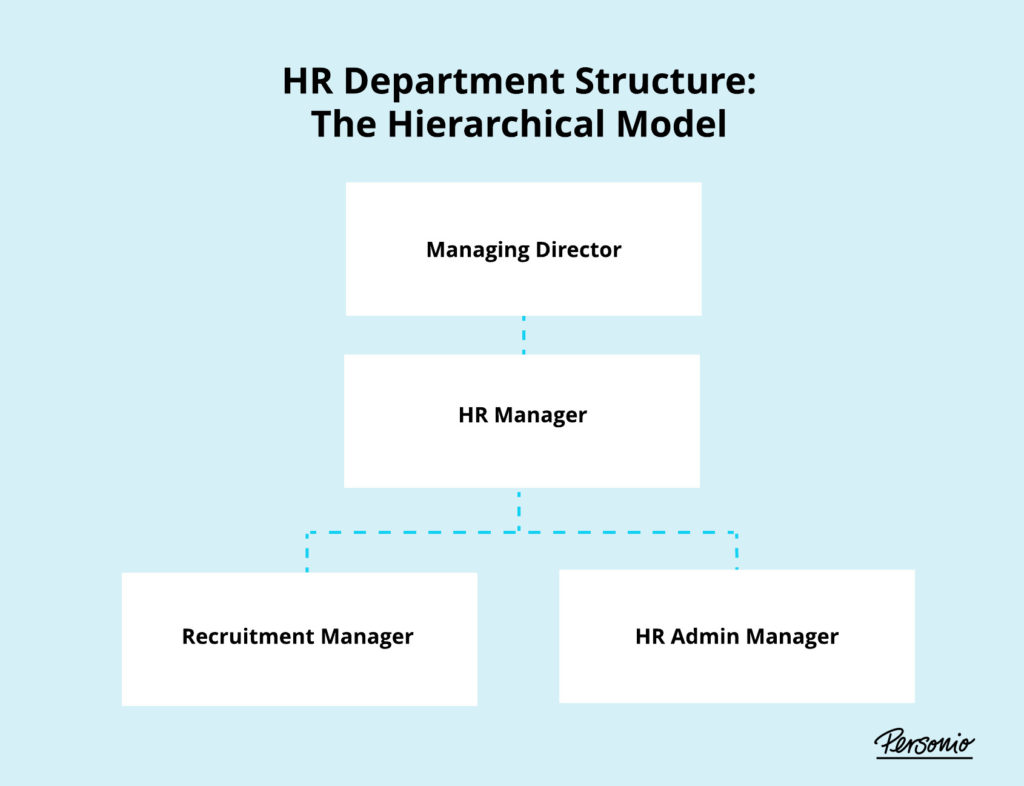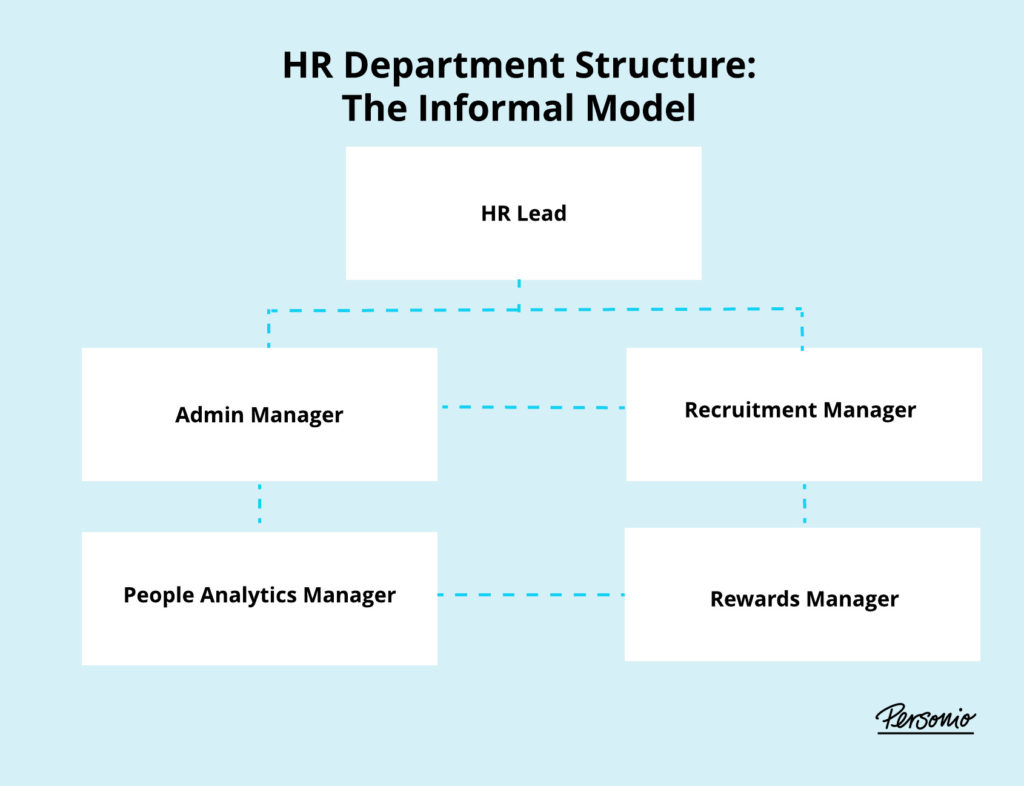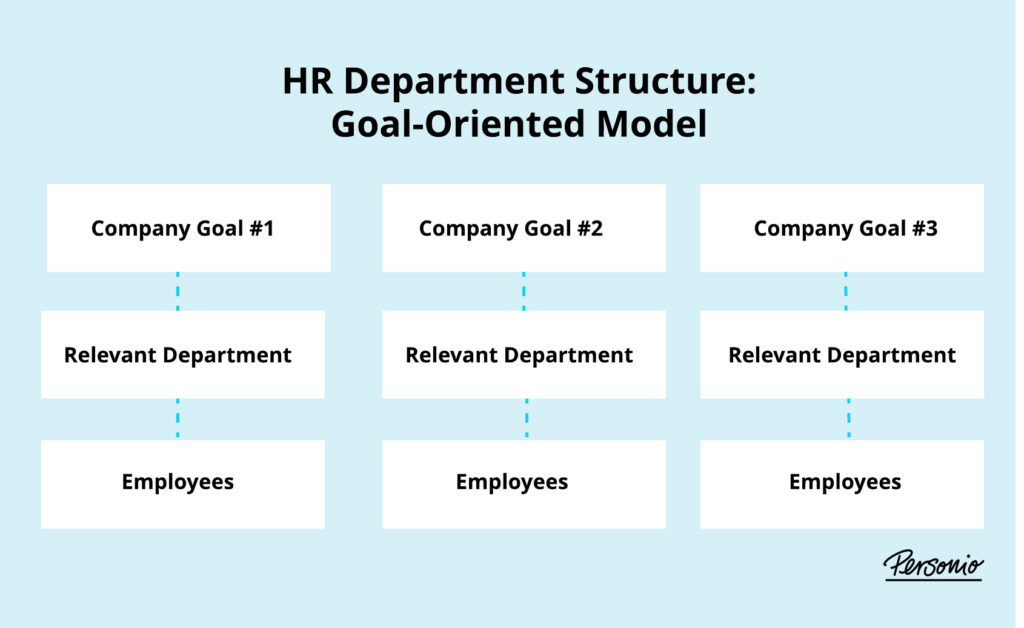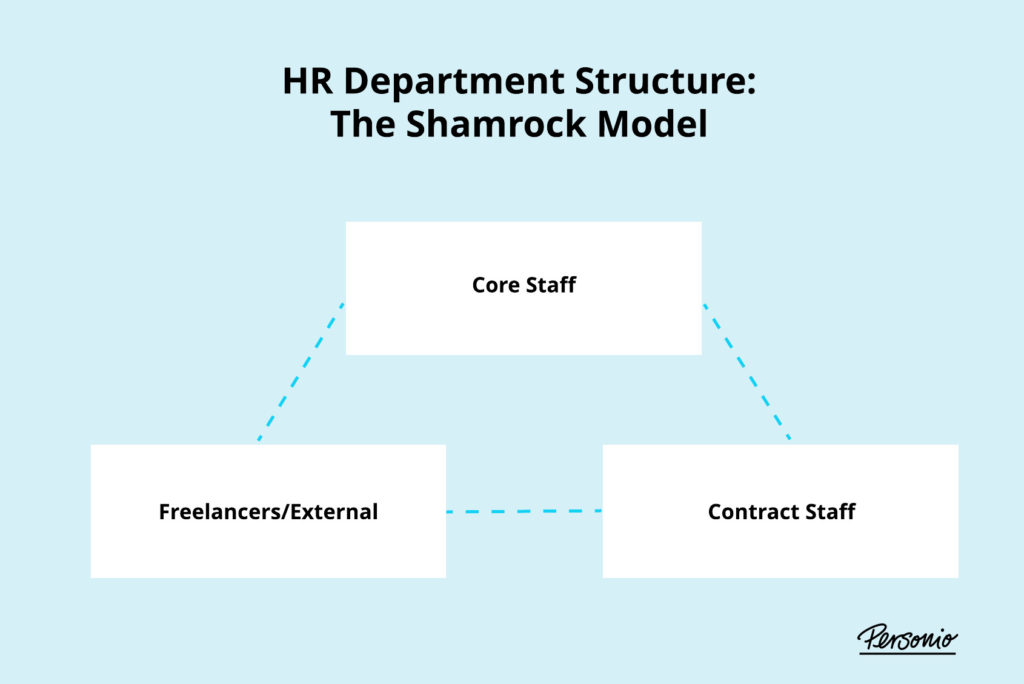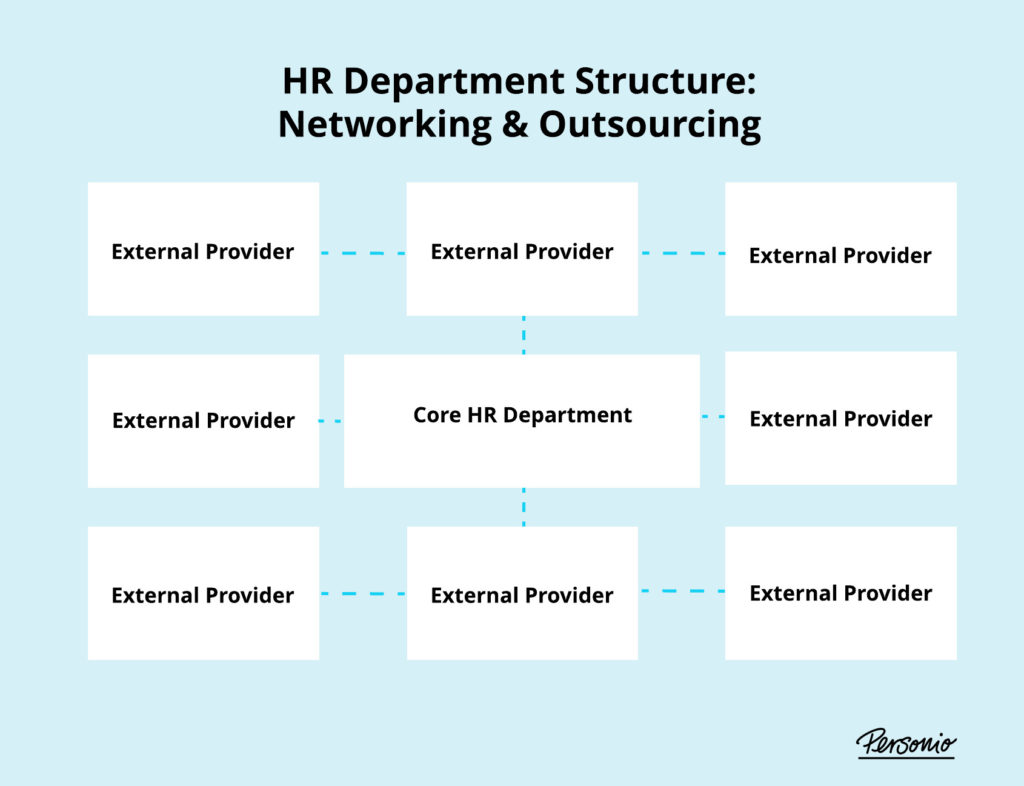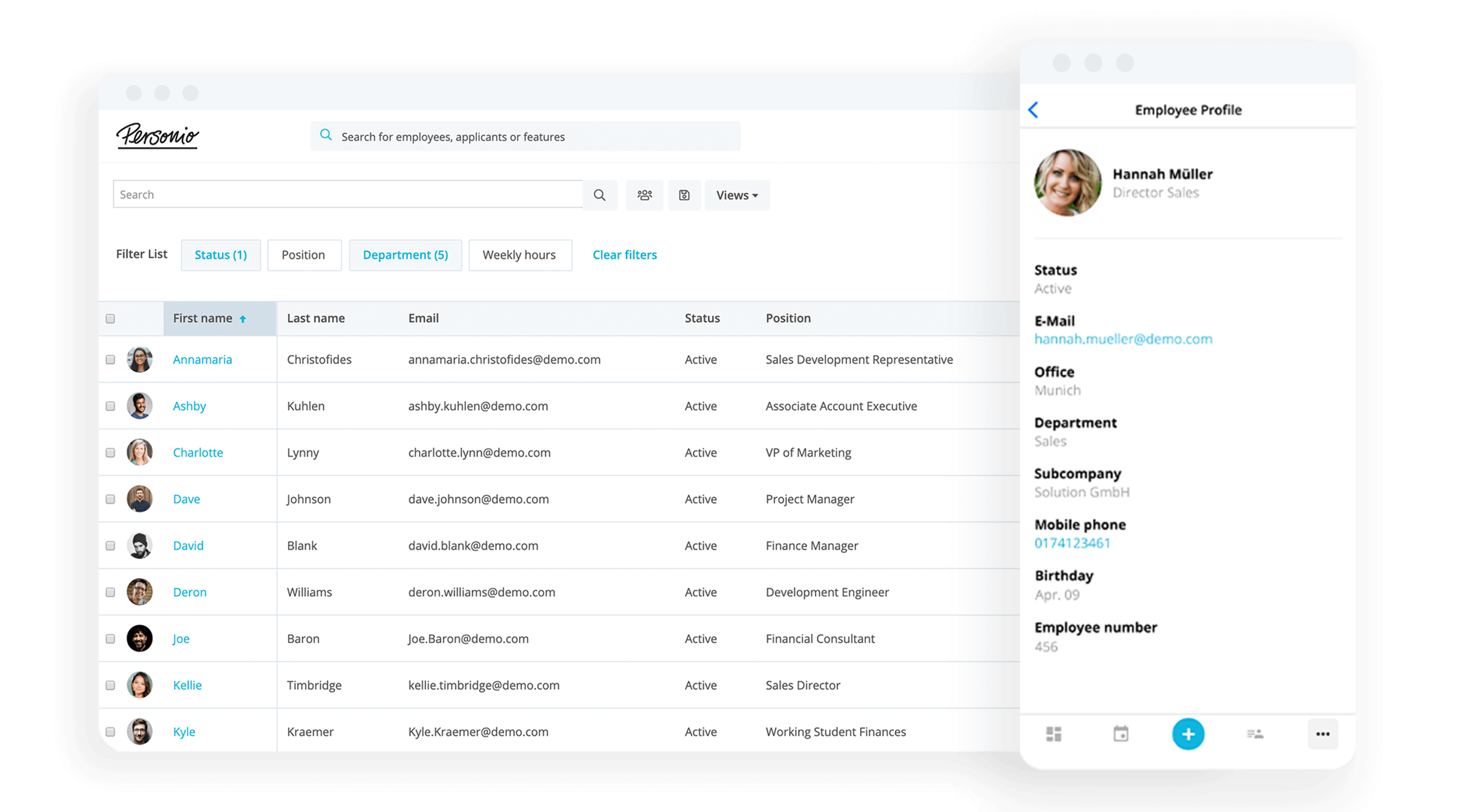When it comes to unlocking your business’ full productive potential, your HR department structure should be step one. In this article, we offer a comprehensive outline on how to structure your HR department, the top considerations you should make and some models (along with the research) that help them perform.
Scale your HR department better with Personio’s HR software.
Contents
What Is A Human Resources (HR) Department?
What Are The Common Tasks Of An HR Department?
Why HR Department Structure Matters
How Large Should Your HR Structure Be?
How Do You Define A Suitable HR Department Structure?
What Are Different Organisational Structures For HR?
How Can You Help Your HR Department Structure Grow?
Can An Org Chart Help Structure Your HR Department?
What Is A Human Resources (HR) Department?
Human resources (HR) is the department of your company that deals with all personnel-related topics and issues. They can serve as the point of contact for employees, managers and, if applicable, governing bodies to ensure that your company is abiding by the law and helping your overall organisation succeed through its people.
What Is A People Team?
Some consider a people team and an HR department as one and the same. That said, a People Team is typically designed with the purpose of strategic initiatives in mind. While they may handle day-to-day HR tasks, they have an even wider lens when it comes to organisational development. They are also likely to have a seat at the management/leadership table.
What Should HR Be Responsible For?
Whether understand as your People Team, or People Operations Team, the idea here is that HR has an ever-widening scope. They are no longer simply limited to administrative tasks, as these are often automated and handled by effective HR software. Instead, your HR department should focus on people and helping them succeed.
What Are The Common Tasks Of An HR Department?
An HR department is typically tasked with assignments across the employee lifecycle. This could include onboarding, offboarding and the following:
| Task | Definition |
|---|---|
| Personnel Planning | In personnel planning, you ensure that your company has the right number of employees with the necessary qualifications at all times to achieve the set goals. |
| Recruitment | Otherwise known as talent acquisition, recruiting, and e-recruiting, this describes all the measures a team needs to complete to reach new employees to benefit the company. This also includes employer branding. |
| Workforce Planning | Ensuring that your employees are deployed as efficiently as possible, to avoid bottlenecks and overcapacity where it shouldn't otherwise exist. |
| Personnel Administration | Describing all the administrative tasks and formalities that fall within an HR department's scope. This could be creating contacts or managing digital personnel files. |
| Development | HR and People Teams need to help employees get better at what they do, and that means establishing strong performance management processes and an open culture of feedback. |
| Payroll | HR also takes care of payroll and salary accounting. This can either happen completely in-house or is partially outsourced and handled jointly with a software provider or tax consultant. |
| Retention | This includes all the measures that an HR department takes to retain employees and lower the company's overall attrition rate. |
| Analytics & Reporting | Every modern HR department needs to make personnel-related decisions informed by hard data. This means having access to people analytics to determine employee headcount, growth rates, costs, and more. |
| Strategy | Administration has always fallen on the plate of HR, but where they can truly succeed is when they focus on strategy. That means having the time to be involved, as well as to implement initiatives. |
What’s the Purpose of HR Department Structure?
As companies grow, they require structure. That’s because start-ups and smaller companies tend to create a family atmosphere and corporate culture, but above a certain size (let’s say between 50-100), everything changes.
That’s because new colleagues are only known from being quickly introduced, and everything becomes more anonymous and less connected. During this phase, many companies report a noticeable drop in employee satisfaction.
But, it doesn’t need to be this way, and it starts in HR. After a certain amount of growth, the HR department must professionalise itself (or reveal itself entirely), while actively taking care of corporate culture and employee retention.
It also must develop salary and working time models and master any increasing bureaucracy. But, if you simply hire more without planning a structure around them, you’ll only ever keep up (and avoid getting ahead).
How Large Should Your HR Department Be?
The well-known rule of thumb, “One HR position per every 100 employees,” is not wrong, but it tends to apply to larger companies with a well-equipped HR department.
In companies with up to 250 employees, the need is significantly higher, as the “Workforce Analytics” study shows: an average of 3.4 HR employees per 100 full-time positions in the company!
Peter Rosen from HR Strategies and Solutions recommends creating the first full-time position in the HR department from around 50 employees and a second from around 150 employees. This recommendation is quite realistic.
Instead of relying on a general figure, you should determine your own HR staffing needs. Learn how to do this while defining a structure for your HR department in the following parts of this article.
3 Steps To Evaluate Your HR Department Structure
When structuring your future HR department, you need to proceed as you would with any other project: you set goals that you want to achieve and then think about the necessary steps to do so. Here is our guide to developing your HR structure…
1. Identify Critical Issues
List all the tasks you need to take care of in the future and assign priorities to the tasks (1-5, let’s say). Identify the critical issues that present a particular challenge and could prove to be a “bottleneck” to continued business growth.
Some common examples include:
- Recruiting certain highly-qualified specialists.
- Implementing flexible working models that could be attractive for families.
- Promoting employee satisfaction so that employees do not leave for (better-paying) competitors.
- Training and further education of employees to remain competitive in your industry.
By identifying these areas of focus, you are already laying the groundwork for a future HR structure. What you may need is an employee to specifically take care of these areas. We’ll cover this a bit later on.
Keep in mind: Make sure to put employer branding and onboarding on your list just as you do payroll, contracting and health care. For each item, list the individual tasks that need to be done and estimate the resources needed to do them.
2. Define HR Processes
Now comes the hard part. If you skip it or do it half-heartedly, the efficiency of your HR will decrease as the size of your company grows. In small companies, HR works on-demand and with informal processes – “that’s just how we do it.” Now you need to define fixed processes to handle the extra work.
Take this list and keep it in mind for defining your HR processes:
- Document all your current HR processes, including responsibilities and relevant tasks.
- Describe how you want to work with external service providers (service-level agreements).
- Work with management to develop a plan for staffing needs (recruitment).
Let’s build on the recruitment example. Here’s how you might break down that process:
- Determine which recruiting channels you want to use.
- Work with departments to create job descriptions, job profiles, training programs.
- Work out standard contracts and other regulations (the keyword here is compliance).
When it comes to your processes, make sure to keep them aligned with your priorities at this stage of time. Kick things off with the critical areas and work out the others later on.
Download our template for requirement profiles here.
Deliver Great HR Processes at Scale
Simplify all your HR processes even as your team grows.
3. Implement An HR Software
Ideally, you should start the selection process for an HR software immediately. Not only is this important to keep everything organised right from the very beginning, but it also makes switching software easier down the road.
Which software you use will help determine how your processes will look. You can automate many tasks right from the start. Data interfaces make it much easier to collaborate with the payroll office and other external service providers.
Don’t put off implementing new software. If you introduce manual processes first and only switch to software later, you will have to change your workflows twice. This is unnecessary and costs time and money.
With software-supported processes, you can easily save half or an entire position in personnel administration. Or, you can assign an employee to other tasks instead.
5 Unique Ways To Structure Your HR Department
There are different ways to go about structuring your HR department. Among them are both more traditional HR structure models and modern ones, too. Whichever one you choose depends entirely on your goals and your corporate culture.
Here are five to get the conversation going:
| Model | Definition | Best For |
|---|---|---|
| The Hierarchical Model | Vertical communication that moves up and down the line based on seniority. | A company that wants a more traditional approach to their HR. |
| Formal and Informal Model | More flexible roles and reporting lines that allow for more agile work. | Start-ups or companies building up their HR department that still want to remain flexible. |
| Goal-Oriented Model | In this model, goals are assigned to departments and team members for achievement. | A scaling company that wants to keep goals in mind. |
| The Shamrock Model | Most relevant tasks are centralized, and additional tasks are typically outsourced to contractors or freelancers. | Smaller companies that want to maintain a core HR team. |
| Networking & Outsourcing | This model is completely dominated by HR departments getting outside help. | Companies who lack the resources but want the expertise of an HR department. |
Now, let’s break each of them down…
1. The Hierarchical Model
A personnel department can be organised hierarchically. The personnel department consists here of a personnel manager, who reports to the managing director and is given department goals, which they must reach together with their team.
The HR department can then consist, for example, of two managers for Recruiting/Personnel Procurement and HR Management/Personnel Administration, who in turn lead their own teams and report to the HR manager.
In this model, communication is completely vertical, i.e., from top to bottom. Information is kicked off by upper management and is then passed through HR management to the executives and ultimately reaches the team.
In this model, the clear distribution of authority is particularly advantageous. Everyone knows where they are in the model, where they want to work and what their development plan is for that purpose.
2. Formal and Informal Model
An HR department can be structured formally or informally. The hierarchical organisation is a good example of the formal model because it is built on clear hierarchies, goals and tasks.
In contrast, the informal model is meant to be freer, because team members can be more flexible and interact with each other depending on the dynamics. There is a more cross-functional capacity here across the team.
In many companies, both models coexist. This means that a standard structure forms the basis of the department, which then operates informally depending on various projects (and the skills required), for a more agile approach.
3. Goal-Oriented Model
With the goal-oriented model, enterprise goals are broken down to individual departments – and even to each individual coworker. Each team decides for itself which measures will be implemented to achieve their goals.
The corporate goals are determined between the CEO and management and require the commitment and dedication of each individual. Ultimately, this model only works if each employee is clear about their goals and how they will be measured against them. In most cases, this model is accompanied by a financial bonus depending on the achievement of goals.
This model is also only partially used in many companies, e.g. in sales. For HR departments, the goal-oriented model results in the following advantages: Commitment and focus from each individual employee, higher team performance and compliant planning of goals.
4. The Shamrock Model
This model borrows from the image of the “shamrock” in that it consists of three basic pillars that together form a whole.
- At the core are the most qualified and relevant employees.
- Less important activities are handled by external service providers and thus outsourced.
- Employees with temporary contracts, e.g. project-based work, complete the cloverleaf.
For the HR department, this means that there is a small core of permanent employees who in turn manage externals on special projects.
External service providers could thus assist with issues such as relocation and employees with temporary contracts, e.g. additional recruiters, can help to recruit more new employees in a shorter period of time.
5. Networking & Outsourcing
This model is completely dominated by HR departments getting outside help.
As a result, there is only a small core of permanent HR employees, who outsource many of the tasks and activities at hand to external service providers to achieve their goals.
How Can You Help Your HR Department Structure Grow?
From the third HR employee onwards, it’s entirely up to you how you structure your organisation’s HR department. You could hire a recruiter if you already employ an assistant or vice versa.
If you can’t find new employees fast enough, you might prefer to hire a second recruiter instead. It all comes down to your priorities, where the critical areas are to meet your company’s goals for growth.
Try and ask yourself:
- What issue is currently getting short shrift and will require more attention in the future?
- What kind of staff, expertise and soft skills are needed to address it?
- What role does the new HR employee need to take on and how does that role fit into the current HR structure?
Instead of increasing the size of your HR department, you could automate or outsource more processes. This gives existing employees more freedom again and allows them to take on new topics – new roles.
Make all decisions based on your previously defined goals and roadmap, which you regularly review and adjust. This way, you can be sure to find the best possible HR structure for you and thus pave the way for the further growth of your company.
Can An Org Chart Help Structure Your HR Department?
Organisational charts for the HR department (and the entire company) help to keep an overview of tasks and areas of responsibility of individual colleagues.
Our guide on what goes into a great org chart.
Get Help Tackling Your Top HR Challenges
Book a demo with a Personio product expert today. They can listen to your top challenges, most-common processes and how you optimise them and help them grow. Build a better foundation for your HR department and reach out today.
Bring All Your
HR Tasks Together

